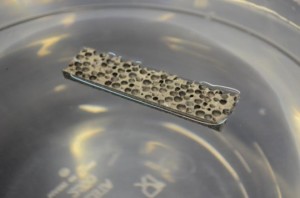Researchers have developed a lightweight metal matrix syntactic foam with a density 8% lower than water which could be ready for prototype testing within 3 years. The work was a collaborative effort by Professor Nikhil Gupta of the NYU Polytechnic School of Engineering and Deep Springs Technology (DST) with the U.S. Army Research Laboratory.
The composite matrix, consisting of a magnesium alloy, is turned into a foam by adding hollow spheres of silicon carbide. These ‘microballoons’ can each withstand a pressure of over 25000 PSI before rupturing, and provide protection by acting as energy absorbers during impact, significantly increasing its strength without adding to its weight. The composite is also versatile. Certain properties of the material, such as its density, can be customized by varying the number of sphere shells in the matrix, and the concept is applicable to non-flammable types of magnesium alloy.
The process of creating a syntactic foam has been in use for many years, but this is the first time it has been applied to a metal. The result is a strong, heat resistant material with low density and high buoyancy that will continue to float on water despite structural damage.
“This new development of very light metal matrix composites can swing the pendulum back in favour of metallic materials,” says Nikhil Gupta, commenting on the recent shift of many industries towards polymer matrix composites in an effort to reduce component weight. The fact that metals can usually withstand much higher temperatures than polymers makes this new lightweight matrix a compelling alternative for manufacturers trying to improve automotive fuel economy.
The involvement of the military is unsurprising – amphibious vehicles, such as the Marine Corps Ultra Heavy-lift Amphibious Connector (UHAC), currently in development, are just one of many projects that stand to benefit from this discovery.
![Floating Metal And Unsinkable Ships: Researchers Develop Composite Metal Foam Researchers have developed a lightweight metal matrix syntactic foam with a density 8% lower than water which could be ready for prototype testing within 3 […]](/wp-content/uploads/2012/12/News-image-01-300x169.jpg)
